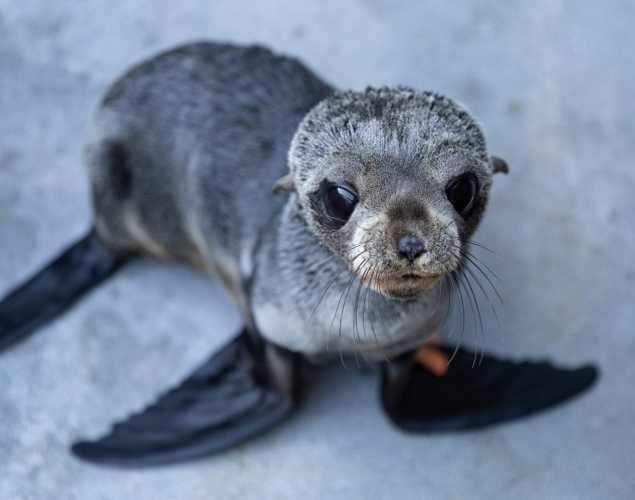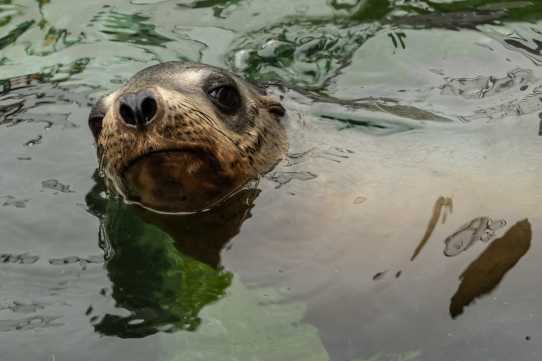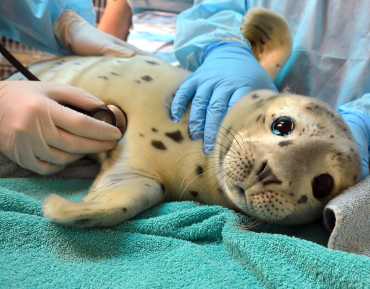
Rescue Stories: Vote for Your Favorite Marine Mammal Patient of 2024!
Thanks to caring people like you, countless marine mammals were rescued in 2024. Now it’s time to recognize some of the most memorable animal rescue stories.
Voting for Patient of the Year for 2024 is now closed.
Here's how you voted:
Sloopy - Guadalupe Fur Seal |
35% |
| Sandia - Pacific Harbor Seal
|
23%
|
| RS10 – Hawaiian Monk Seal
|
21% |
| Chunky - Northern Elephant Seal
|
10% |
| Titanium - Northern Fur Seal
|
6% |
| Pasha - California Sea Lion
|
5% |
|
|
|
Get updates on patients like these delivered straight to your inbox!
Adopt Your Favorite!
Want to show your favorite patients even more love? Each one of our Patient of the Year nominees is available as a digitally downloadable Adopt-a-Seal®! Your symbolic adoption comes with a certificate featuring the patient’s photo and story, and proceeds support the life-saving care for the next sick or injured animal.
Thank you for giving our marine mammal patients a second chance at life—none of this conservation work would be possible without you!
Pasha - California Sea Lion
Rescued: September 11, 2024
Released: October 16, 2024
Diagnosis: Malnutrition, leptospirosis
California sea lion Pasha was in bad shape when he was spotted on a dock. Thankfully, a concerned beachgoer called our hotline to report this starving and lethargic sea lion. Once at our hospital, Pasha immediately started drinking water. Marine mammals generally don’t need to drink water because they receive all their hydration from food sources. This signaled to our experts that he was suffering from leptospirosis, a bacterial infection that affects the kidneys and can be fatal if left untreated. Tests confirmed Pasha’s diagnosis, and he was prescribed antibiotics, fluids and other supportive care. Leptospirosis is a serious disease that can also infect humans and dogs. What our scientists learn from treating patients like Pasha helps us better understand what causes an outbreak, how we can improve treatment for infected animals and how to protect humans as well. After about a month, Pasha recovered and was released to his ocean home with a second chance at life.

Chunky - Northern Elephant Seal
Rescued: February 15, 2024
Released: May 8, 2024
Diagnosis: Malnutrition, maternal separation
When northern elephant seal Chunky was first spotted, he was skinny and still had his blackcoat, or baby fur, which elephant seals shed once they’ve weaned from their mother. But because he was alert, our trained responders monitored Chunky for several days hoping for signs of improvement. Sadly, Chunky remained lethargic, plus off-leash dogs posed a potential threat, so our experts rescued this young pup. Chunky’s experience is not uncommon as harassment from people and dogs is one of the top reasons these young animals are rescued. Luckily for Chunky and pups like him, this can be prevented by keeping your distance and leashing your pets. Once at our hospital, Chunky’s big personality made him a favorite among animal care experts, who were pleased to see him respond well to initial treatment and begin to gain weight. After about three months of care that included a healthy dose of herring, medicine and lessons in “fish school,” he was released back to the wild alongside other rehabilitated seals.

Titanium - Northern Fur Seal
Rescued: August 3, 2024
Released: September 6, 2024
Diagnosis: Malnutrition, domoic acid toxicosis
With people crowded much too closely around her, northern fur seal Titanium was found on the beach seizing and malnourished. If you ever see a marine mammal in distress, it’s important to give them space and call our hotline at 415-289-7325 (SEAL). It’s rare for adult fur seals like Titanium to come to shore and it was clear she needed help, so our trained responders brought her into our care. Titanium was seizing upon arrival, and she was diagnosed with domoic acid toxicosis, a potentially deadly condition that attacks the brain and heart. Despite not eating at first, Titanium was swimming frequently and displaying appropriate grooming behaviors, hopeful signs that she would recover. Slowly, this fur seal regained her strength and eventually began catching and eating live fish. After about a month of dedicated care, Titanium was granted a clean bill of health and released with a second chance.

Sandia - Pacific Harbor Seal
Rescued: February 16, 2024
Released: May 9, 2024
Diagnosis: Malnutrition, maternal separation, prematurity
When harbor seal Sandia was brought to our hospital, our veterinary experts saw signs revealing that she was just days old and likely born prematurely. Not only was part of her umbilical cord attached, but she still had a whitish lanugo coat that is usually shed in utero before birth. Since a pup as young as Sandia would still be nursing with her mother in the wild, our animal care experts initially fed her a special formula gently through a tube to ensure she got vital neonatal nutrients. As Sandia got stronger and her teeth came in, she began lessons in “fish school” where specially trained volunteers used tactics like dragging fish on a string through the water to encourage her natural instinct to chase prey. After months of care, Sandia had learned critical survival skills and more than tripled in body weight. Our experts determined that Sandia was ready for life in the wild, and she returned to the ocean with a second chance.

Sloopy - Guadalupe Fur Seal
Rescued: August 22, 2024
Released: November 1, 2024
Diagnosis: Malnutrition, pneumonia, enteropathy
Guadalupe fur seal Sloopy was stranded in a harbor looking skinny and exhausted. As a species that lives in the open ocean, fur seals like Sloopy rarely come to shore unless they are sick or injured, so it was clear to our trained responders that something was very wrong. Sloopy was brought to our hospital where our veterinarians did a thorough admit exam. Along with malnutrition, Sloopy was diagnosed with pneumonia, an infection in his lungs. He was put on a personalized treatment plan that included plenty of nutritious fish and medicine to build his strength. In the months that followed, Sloopy gained a healthy amount of weight and showed our animal care experts he had mastered the foraging skills to thrive in the wild. Each individual Guadalupe fur seal is essential to saving this threatened species, and thanks to caring people like you, Sloopy was released back to his ocean home.

RS10 – Hawaiian Monk Seal
Rescued: March 22, 2024
Released: April 4, 2024
Diagnosis: Trauma, human interaction
At 8 months old, Hawaiian monk seal RS10 was brought to Ke Kai Ola, our hospital that’s dedicated to this endangered species, after he was spotted with a fishing line in his mouth. Hawaiian monk seals are one of the most endangered animals in the world, so each seal is essential to saving this species from extinction. Once in our care, RS10 underwent an admit exam, which included our experts taking a series of X-rays. These tests confirmed this young seal had a fishing hook lodged midway down his esophagus. Ingested fishing gear is life-threatening, making this intervention necessary for RS10’s survival. Fortunately, our experts utilized special dehooking tools while RS10 was under anesthesia to safely remove the ingested hook, allowing them to avoid a more complex surgery and longer recovery for this monk seal. After his procedure, RS10 recovered well and was provided hearty fish meals to help him regain his strength. It wasn't long after that he returned to his ocean home on Kaua‘i.

Patient images © The Marine Mammal Center / NOAA permit #24359
Yes, I want to save a life!

Yes, I want to save a life!
You’ll be giving sick and injured animals the best possible care at the Center’s state-of-the-art hospital. With your gift today, you are giving a patient a second chance at life in the wild.
See Our Latest News
{"image":"\/Animals\/Wild\/Hawaiian monk seal\/cropped-images\/hms-wild-photo-1-c-noaa-pifsc-hmsrp-35-0-1270-992-1759760452.jpg","alt":"A Hawaiian monk seal rests on its side on a sandy beach.","title":"Where Do Hawaiian Monk Seals Live? And Other \u2018\u012alio Holo I Ka Uaua Trivia","link_url":"https:\/\/www.marinemammalcenter.org\/news\/where-do-hawaiian-monk-seals-live-and-other-ilio-holo-i-ka-uaua-trivia","label":"News Update","date":"2025-10-06 00:00:00"}

Where Do Hawaiian Monk Seals Live? And Other ‘Īlio Holo I Ka Uaua Trivia
October 6, 2025
Read More{"image":"\/Animals\/Patients\/California sea lions\/2025\/cropped-images\/dottie-csl-photo-by-bill-hunnewell-218-0-1270-992-1759777087.jpg","alt":"California sea lion","title":"LA Times: Marine mammals are dying in record numbers along the California coast","link_url":"https:\/\/www.marinemammalcenter.org\/news\/la-times-marine-mammals-are-dying-in-record-numbers-along-the-california-coast","label":"In the News","date":"2025-10-03 02:00:00"}

LA Times: Marine mammals are dying in record numbers along the California coast
October 3, 2025
Read More{"image":"\/People\/Action\/Veterinary care\/cropped-images\/dane-whitaker-and-emily-whitmer-vaccine-trial-by-bill-hunnewell-49-0-1270-992-1757364612.jpg","alt":"Two veterinarians collect a blood sample from an elephant seal in a rehabilitation pen.","title":"Bird Flu Vaccine Trial May Offer Hope for Protecting Hawaiian Monk Seals","link_url":"https:\/\/www.marinemammalcenter.org\/news\/bird-flu-vaccine-trial-may-offer-hope-for-protecting-hawaiian-monk-seals","label":"News Update","date":"2025-09-09 09:13:00"}

Bird Flu Vaccine Trial May Offer Hope for Protecting Hawaiian Monk Seals
September 9, 2025
Read More{"image":"\/Animals\/Patients\/Elephant seals\/2025\/cropped-images\/es-vaccine-trial-satellite-tag-by-bill-hunnewell-218-0-1270-992-1757432410.jpg","alt":"Northern elephant seal","title":"The New York Times: Scientists Begin Testing Bird Flu Vaccine in Seals","link_url":"https:\/\/www.marinemammalcenter.org\/news\/the-new-york-times-scientists-begin-testing-bird-flu-vaccine-in-seals","label":"In the News","date":"2025-09-09 02:00:00"}

The New York Times: Scientists Begin Testing Bird Flu Vaccine in Seals
September 9, 2025
Read More